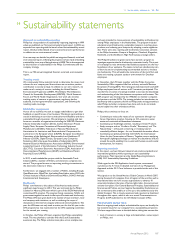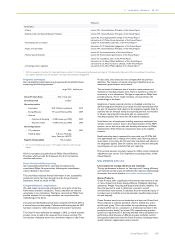Philips 2012 Annual Report Download - page 195
Download and view the complete annual report
Please find page 195 of the 2012 Philips annual report below. You can navigate through the pages in the report by either clicking on the pages listed below, or by using the keyword search tool below to find specific information within the annual report.
14 Sustainability statements 14.5 - 14.5
Annual Report 2012 195
• Emergency preparedness: inadequate fire detection and suppression
systems, blocked or insufficient emergency exits
• Occupational safety: worker exposure to safety hazards, e.g.
electrical shocks
• Lack of adequate management systems to safeguard compliance to
the EICC code for labor and ethics, health and safety and
environment
Compared to 2011 we note on average per audit 8% more non-
compliances for wages and benefits, and in particular full payment of all
overtime premiums is an issue. Suppliers reported difficulties in
implementing the yearly legal wage increases in China, especially in the
current weak economic environment. For industrial hygiene and
occupational safety non-compliances we observe a 9% and 7% increase
respectively, which is mainly due to the application of new and stricter
legislation in China.
Areas where we observe improvements compared to previous year
are mainly related to environmental impact, especially for
environmental permits and reporting, pollution prevention and
resource reduction, and product content restrictions. These
improvements are the result of increased enforcement and
management awareness, and we believe that the Philips programs have
contributed to this.
Excessive working hours
In China, there is a wide gap between legislated working hours and
reality. Especially in regions with high shares of migrant workers a 72
hour working week is not uncommon. While this issue is not unique
to Philips, we have decided to take a step-wise approach by working
with our suppliers to reduce to a maximum of 60 work hours per week
and at least one day off per week, except in emergency or unusual
circumstances.
During the 2012 audits we identified 119 suppliers with working weeks
exceeding 60 hours, and 88 cases where workers were not provided
with one day off per week. In these cases we require suppliers to submit
a corrective action plan taking into account factors like employee
turnover, seasonality, workforce size, shift structure, productivity,
demand planning, etc.
Management systems
There may be areas where our audits reveal compliance in actual
practice, but the related underlying management systems to safeguard
continued compliance may not be sufficient. Therefore, also
management systems are reviewed during the audits. We see this area
as a continued weak area at suppliers where further capacity building
is necessary. Related to management systems the most frequently
observed areas of non-compliance are insufficient risk assessment and
self-audits, absence of performance objectives, and a lack of worker
feedback and communication.
More information on the Supplier Sustainability Involvement Program,
the Philips Supplier Sustainability Declaration and audit approach can
be found at www.philips.com/suppliers.
























